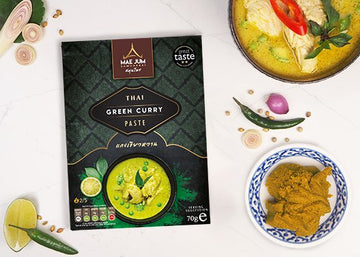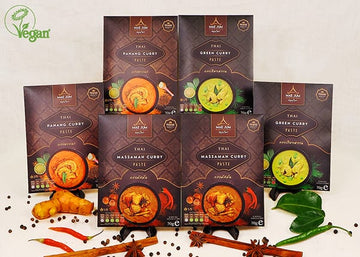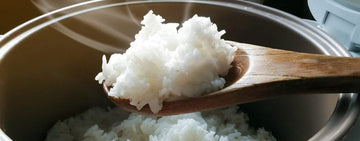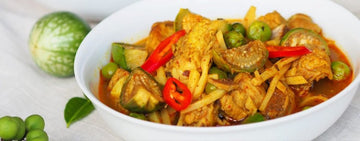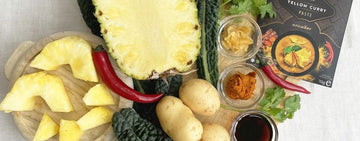Thailand is the second-largest rice exporting country in the world. In Thailand and many other countries in Asia, rice is a staple diet and is essential to Thai cuisine. Rice would always be seen on the table and is often served with most of the meals, including breakfast, lunch, dinner, snacks and desserts!
Understanding Rice Texture
Rice is a grain that is very versatile, it can be made into a sticky and sauce soaking tool, a creamy base or into light and fluffy aromatic moulds. Each variety of rice will differ in taste and texture from one another and this depends on the two different starches content ratio. The two different starches are amylose and amylopectin. For lighter and fluffier rice the content of amylose needs to be higher, for kinds of rice with more amylopectin content, the stickier and creamier it will be!
Nutrition and Colour
There are many varieties of white and coloured rice that hold different nutritional values. In simple terms, the darker and more intact the rice grain is, the more nutritious it is. Rice varieties such as brown, black and red rice all contain valuable antioxidants, minerals and vitamins whereas most varieties of white rice are simply a source of carbohydrates. In Thai cuisine, you don’t often see main course dishes use coloured rice, but there are a few desserts that call for brown rice.
Jasmine Rice
Jasmine rice is native to Thailand and is named after the fragrant Jasmine flower. You will notice that jasmine rice also has a beautiful aroma and is sometimes referred to as fragrant rice. Jasmine rice is a long-grain rice with higher amylopectin content than average which means it is a little bit sticky when cooked but still has a light, fluffy and delicate texture. Jasmine rice flavour is sweet and nutty and goes beautifully with the spices used in Thai cuisine

How to Cook Jasmine Rice
To keep its fluffy texture, jasmine rice should be steamed rather than boiled. The standard ratio for cooking rice is 1 part rice to 1.5 parts water, but for jasmine rice, you should use less water. I would recommend using 1.25 part water for 1 part water and if you prefer to rinse or soak your rice before cooking, you should use even less water!
The cooking process is simple, place rice and water in a pot and bring it to a boil on high heat. Once boiling, reduce the heat to allow the rice to simmer, cover with a tight-fitting lid and leave to cook until all the water is absorbed. Cook for about 10 - 12 minutes and then turn off the heat and leave to rest for about 10 minutes. By resting the rice whilst still covered will carrying on cooking the rice in its steam and the end result will be perfect jasmine rice!
It is important not to disturb the rice whilst it is cooking, so resist the urge to stir, the only time you should touch it is when you are about to serve. Jasmine rice can also be prepared in a rice cooker (our preferred method). I would recommend investing in a rice cooker as it will make perfect rice every time. The built-in thermometer measures the temperature of the water and rice and will automatically switch off or to a warm setting when it detects that all the water has been absorbed.
Glutinous (Sticky) Rice
More informally known as sticky rice, this variety is native to Southeast and East Asia. Glutinous rice only contains amylopectin, which means it is sticky when it is cooked. The rice grains are opaque and short, it can be eaten with the bran on or removed. The bran intact is known as brown sticky rice and removed with white sticky rice. In Thailand, sticky rice is eaten during any time of the day, including breakfast, lunch, dinner and desserts.

How to Cook Sticky Rice
Traditionally, sticky rice is steamed in a bamboo basket which allows the rice to cook evenly and gradually releases its starch but there is another way of cooking if you don’t have one. But first, you must soak the rice in a bowl of water for a few hours, make sure there is more than enough water as the rice will swell over time - I like to do this overnight if eating it for lunch or first thing in the morning for dinner.
If you don’t have a bamboo basket, you can still cook the perfect sticky rice by place a colander inside a large pot with a natural fabric such as muslin laid over the colander. Drain the soaked rice into the colander and add more water so that it nearly reaches the bottom of the colander. Cover with a lid and bring to a simmer, leave to steam for 15-20 minutes. About halfway through, flip the rice by grabbing the muslin edges and tilting it to turn/flip the rice over. Serve as soon as it is ready!
Thai Fried Rice
Every Asian country has their own version of fried rice and in this section, I’m going to tell you how fried rice is made in Thailand! Traditionally, Thai fried rice is not made with soya sauce, if you add soya sauce it becomes Chinese fried rice (also very tasty!). Another difference between Thai and Chinese fried rice is that Thai is made with jasmine rice and Chinese with another variety of long-grain rice. Fried rice can be served as a side or as a breakfast meal with fresh slices of cucumber. There are many versions of fried rice, below is just one!

How to Make Thai Fried Rice
You will (of course) need rice that is already cooked. Cold leftover rice is best for this dish as the grains are fried out and are easy to separate when stir-frying. Freshly cooked rice becomes sticky and glued together when stir-fried. To cook, heat oil in a large wok and add onions and garlic, stir fry for about 30 seconds. Next, add a choice of protein (I usually go for prawns or chicken) with the white part of spring onion and stir fry for another minute.
Push everything to one side and crack an egg onto the other, scramble the egg quickly for about 30 seconds. Add the rice and sauce of choice, continue to stir fry for a few minutes and then add the green part of the spring onion halfway through. The choice of sauce is up to you, I usually cook with fish sauce + oyster sauce for anything seafood or Thai seasoning sauce for meat or vegetables. Once everything is cooked and stir-fried well, serve immediately and garnish with fresh coriander, spring onions, tomatoes and cucumbers!
If you enjoyed this article, please leave a rating and comment! Browse our blog for more, and subscribe for new recipes. Stay connected on Instagram and Facebook.
